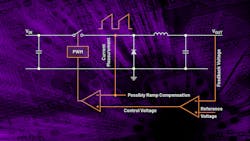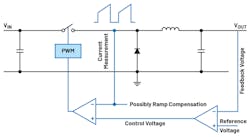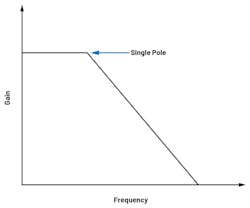Why Does Current-Mode Control in Switching Regulators Matter?
Members can download this article in PDF format.
What you'll learn:
- How does a current-mode regulator operate?
- Advantages of current-mode regulators.
- Disadvantages of current-mode regulators.
Thousands of different switching regulators are available on the market. Selection is based on specifications such as input-voltage range, output-voltage capability, maximum output current, and a slew of other parameters. This article explains current mode, a differentiating feature commonly listed in datasheets, and its advantages and disadvantages.
Current-Mode Regulators Explained
Figure 1 shows the basic working principle of a current-mode regulator. Here, the feedback voltage is not only compared with an internal voltage reference, but also with a sawtooth voltage ramp for generating the necessary pulse-width-modulation (PWM) signal for the power switch.
The slope of this ramp is fixed in voltage-mode regulators. In current-mode regulators, the slope depends on the inductor current and is yielded from the current measurement shown in Figure 1 at the switching node. This is what differentiates current-mode regulators from voltage-mode regulators.
Advantages of Current-Mode Regulators
Current-mode regulators offer many advantages. One is that the inductor current immediately adapts to changes in the input voltage (VIN in Figure 1). Thus, the input-voltage change information is directly fed into the control loop, even before the output voltage (VOUT in Figure 1) tracks this input-voltage change.
The advantages of current-mode control are so convincing that most switching-regulator ICs on the market work according to this current-mode control principle.
Another key advantage is simplified control-loop compensation. The Bode plot of a voltage-mode regulator shows a double pole; a current-mode regulator generates just one simple pole of the power stage at this point. This produces a phase shift of 90 degrees instead of the 180 degrees with a double pole. Thus, a current-mode regulator can be much more easily compensated and subsequently stabilized. Figure 2 shows the simple transfer function of the power stage of a typical current-mode regulator.
Disadvantages to Weigh
However, a few disadvantages exist alongside the mentioned advantages. Current-mode regulators can’t immediately make the required current measurements after a switching transition because the noise will couple into the measurement strongly at this time. It takes a few nanoseconds for the noise caused by the switching to subside. This is called the blanking time. It normally results in a somewhat longer minimum on-time specification than for voltage-mode regulators.
Another disadvantage of current-mode regulators is the possibility, in principle, of a subharmonic oscillation (Fig. 3). If a duty cycle of greater than 50% is required, a current-mode regulator may alternately execute short and long pulses. In many applications, this is considered instability, which should be avoided.
To overcome this issue, a certain ramp compensation can be added to the generated current ramp shown in Figure 1. It can shift the critical duty-cycle threshold to well above 50% so that even at higher duty cycles, there are no subharmonic oscillations.
Even these earlier mentioned restrictions, due to the blanking time and the resultant duty-cycle limitations, can be circumvented through the IC design. For example, one remedy is to incorporate low-side current sensing where the inductor current is measured during the off-time rather than the on-time.
Conclusion
All in all, the advantages of current-mode control in switching regulators outweigh the disadvantages for most applications. And through various circuit innovations and modifications, the disadvantages can be bypassed. That’s why most switching-regulator ICs today use current-mode control.



